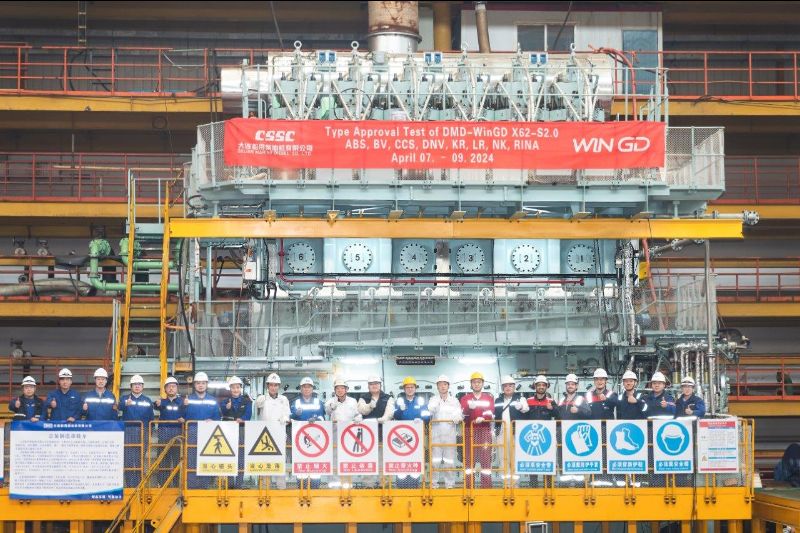Super Typhoon Haiyan shortly after landfall. Image courtesy NOAA.
By Brian K. Sullivan, Cecilia Yap and Joel Guinto
Nov. 8 (Bloomberg) — Super Typhoon Haiyan, the equivalent of a Category 5 hurricane, slammed into the Philippines today after forcing thousands of people to evacuate.
Haiyan had top winds of almost 196 miles (315 kilometers) per hour when it was about 489 miles southeast of Manila, the U.S. Navy’s Joint Typhoon Warning Center said at 2 p.m. East Coast time. Winds gusted to as high as 235 mph, the Navy said. About 125,600 people in 22 provinces have been evacuated, the nation’s disaster monitoring agency said in a 6 a.m. bulletin.
“If it maintains its strength, there has never been a storm this strong making landfall anywhere in the world,” said Jeff Masters, founder of Weather Underground in Ann Arbor, Michigan. “This is off the charts.”
SEE EARLIER: Super Typhoon Haiyan Approaches Philippines as One of Strongest Storms Ever
The storm went ashore at about 5 a.m. in Guiuan, eastern Samar, said the Philippines Atmospheric, Geophysical and Astronomical Services Administration. Twenty-one areas mostly on the island of Visayas, which suffered a 7.2-magnitude earthquake last month, are on highest storm alert. President Benigno Aquino, in a televised address last night, warned of serious danger and said Haiyan may cause more damage than storm Bopha, which killed more than 1,000 people in Mindanao in December.
The Philippines, battered by about 20 cyclones a year, was the nation most affected by natural disasters in 2012, with more than 2,000 people killed, according to the Brussels-based Centre for Research on the Epidemiology of Disasters.
Storm Surges
Monsoon rains swamped more than half of the Manila region in August, causing at least 27 deaths and shutting offices and financial markets for two days.
The nation’s financial markets will open today even as Bangko Sentral ng Pilipinas Deputy Governor Nestor Espenilla said “there’s a need to closely monitor” the situation.
Haiyan may inundate rivers, create mudflows and cause storm surges as high as 6 meters (20 feet), Aquino said. Three air force cargo planes, 2 navy ships, helicopters and relief boats are on standby, the president said. About 78,000 families were evacuated in Albay province, Governor Joey Salceda said on his Facebook account.
Masters said Tacloban, the capital of the Philippine province of Leyte, would take a direct hit and winds of at least 130 mph may sweep as far as 100 miles inland.
“There isn’t much built on the Philippines that can withstand winds like that,” Masters said.
Catastrophic Damage
Heavy rains from storms usually cause the highest death tolls on the Philippines, Masters said. Flooding may not be the worst threat this time because Haiyan is moving fairly fast. The high winds and storm surge have the potential to cause catastrophic damage, he said.
“We’re swamped with calls for help,” Southern Leyte Governor Roger Mercado said in an interview over DZMM radio. Strong wings uprooted trees in the province, he said.
About 2,000 passengers, 50 vessels and 557 rolling cargoes are now stranded in various seaports, the disaster agency said today. Cebu Air Inc., the nation’s largest budget carrier, canceled 122 domestic flights and 4 international flights from today to Nov. 9, it said yesterday. Philippine Airlines Inc., in its Facebook account, said 26 local flights and three international flights have been canceled today.
Storm Records
The true power of Haiyan isn’t known because reconnaissance planes haven’t flown into it, Masters said. The strongest tropical cyclone on record was Super Typhoon Nancy in 1961 with top winds of 215 mph. He said many believe the estimated wind speeds of storms between the 1940s to 1960s was too high.
Since 1969, only three storms have been as powerful as Haiyan, Masters wrote on his blog. They were Super Typhoon Tip in 1979 in the Pacific and Atlantic hurricanes Camille in 1969 and Allen in 1980.
The strongest storm to hit land was Camille, which went ashore in Mississippi with winds near 195 mph, Master said. While there are some estimates that Camille’s winds were closer to 200 mph, the exact speed is unknown because the instruments were destroyed, according to the U.S. National Hurricane Center.
The Philippines government has placed relief supplies worth 195 million pesos ($4.5 million) in Samar and Leyte islands in the Visayas, Communications Secretary Sonny Coloma said in Manila yesterday.
After crossing the Philippines, Haiyan is expected to strike Vietnam in several days, according to the Japanese Meteorological Agency.
“It is going to be a huge problem for Vietnam and Laos,” Masters said. As much as a foot of rain may fall there, he said.
Copyright 2013 Bloomberg.

 Join The Club
Join The Club










